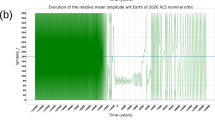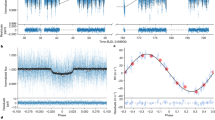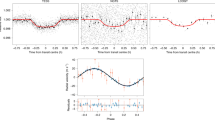Abstract
Recent years have seen the discovery of several objects in stable orbits in the outer Solar System1,2,3; these bodies include objects in the Kuiper belt (also known as the Kuiper–Edgeworth belt) as well as the Centaurs. Moreover, another region of orbital stability has been identified between the orbits of Uranus and Neptune4. Here we report evidence from numerical simulations of zones of orbital stability in the inner Solar System. We find that there are two possible long-lived belts of asteroids. The first region lies between the Sun and Mercury, in the range 0.09–0.21 astronomical units, where remnant planetesimals may survive for the age of the Solar System provided that their radii are greater than ∼0.1 kilometres. The second region of stability is between Earth and Mars (range 1.08–1.28 astronomical units), where a population of bodies that are on circular orbits may survive. A search through the catalogues of near-Earth objects reveals an excess of asteroids with low eccentricities and inclinations occupying this latter region: several examples are the recently discovered objects 1996 XB27, 1998 HG49 and 1998 KG3.
This is a preview of subscription content, access via your institution
Access options
Subscribe to this journal
Receive 51 print issues and online access
$199.00 per year
only $3.90 per issue
Buy this article
- Purchase on Springer Link
- Instant access to full article PDF
Prices may be subject to local taxes which are calculated during checkout

Similar content being viewed by others
References
Kowal, C. T. in Asteroids(ed. Gehrels, T.) 436–439 (Univ. Arizona Press, Tucson, (1979).
Jewitt, D. & Luu, J. X. Discovery of the candidate Kuiper belt object 1992 QB1. Nature 362, 730– 732 (1993).
Williams, I. P., O'Cellaigh, D. P., Fitzsimmons, A. & Marsden, B. G. The slow-moving objects 1993 SB and 1993 SC. Icarus 116, 180–185 ( 1995).
Holman, M. J. Apossible long-lived belt of objects between Uranus and Neptune. Nature 387, 785–788 ( 1997).
Wisdom, J. & Holman, M. J. Symplectic maps for the n-body problem. Astron. J. 102, 1528– 1538 (1991).
Saha, P. & Tremaine, S. D. Symplectic integrators for solar system dynamics. Astron. J. 104, 1633– 1640 (1992).
Saha, P. & Tremaine, S. D. Long term planetary integration with individual time steps. Astron. J. 108, 1962–1969 (1994).
Holman, M. J. & Wisdom, J. Dynamical stability in the outer solar system and the delivery of short period comets. Astron. J. 105, 1987–1999 ( 1993).
Danby, J. M. A. Fundamentals of Celestial Mechanics(Willmann-Bell, Richmond, ( 1988).
Mikkola, S. & Innanen, K. Solar system chaos and the distribution of asteroid orbits. Mon. Not. R. Astron. Soc. 277, 497–501 (1995).
Weidenschilling, S. J. Iron/silicate fractionation and the origin of Mercury. Icarus 35, 99–111 (1978).
Leake, M. A., Chapman, C. R., Weidenschilling, S. J., Davis, D. R. & Greenberg, R. The chronology of Mercury's geological and geophysical evolution—The Vulcanoid hypothesis. Icarus 71, 350–375 ( 1987).
Campins, H., Davis, D. R., Weidenschilling, S. J. & Magee, M. in Completing the Inventory of the Solar System(eds Rettig, T. W. & Hahn, J. M.) 85–96 (ASP Conf. Proc., Astron. Soc. Pacif., San Francisco, (1996).
Dones, L., Levison, H. F. & Duncan, M. in Completing the Inventory of the Solar System(eds Retting, T. W. & Hahn, J. M.) 233–244 (ASP Conf. Proc., Astron. Soc. Pacif., San Francisco, (1996).
Weissman, P. R., A'Hearn, M. F., McFadden, L. A. & Rickman, H. in Asteroids II(eds Binzel, R. P., Gehrels, T. & Matthews, M. S.) 880–920 (Univ. Arizona Press, Tucson, (1989).
Robertson, H. P. Dynamical effects of radiation in the solar system. Mon. Not. R. Astron. Soc. 97, 423–438 (1937).
Pettit, E. in Planets and Satellites(eds Kuiper, G. P. & Middlehurst, B.) 400–427 (Univ. Chicago Press, (1961 ).
Bowell, E. G. The Asteroid Orbital Element Databaseat 〈ftp://ftp.lowell.edu/pub/elgb/astorb.html 〉.
McFadden, L. A., Tholen, D. J. & Veeder, G. J. in Asteroids II(eds Binzel, R. P., Gehrels, T. & Matthews, M. S.) 442–467 (Univ. Arizona Press, Tucson, (1989).
Gladman, B. et al . Dynamical lifetimes of objects injected into asteroid belt resonances. Science 277, 197– 201 (1997).
Saha, P., Stadel, J. & Tremaine, S. D. Aparallel integration method for solar system dynamics. Astron. J. 114, 409–414 (1997).
Acknowledgements
We thank P. Saha and S. Tremaine for suggestions and comments, as well as their advice on computational matters, and J. Chambers, M. Holman and L. Dones for helpful criticism. The Royal Society supported the purchase of dedicated computers, and we also thank the Oxford Supercomputing Centre (OSCAR) for support.
Author information
Authors and Affiliations
Corresponding author
Rights and permissions
About this article
Cite this article
Evans, N., Tabachnik, S. Possible long-lived asteroid belts in the inner Solar System. Nature 399, 41–43 (1999). https://doi.org/10.1038/19919
Received:
Accepted:
Issue Date:
DOI: https://doi.org/10.1038/19919
This article is cited by
-
Vulcan and the anomalous displacement of Mercury’s perihelion - a historical and numerical perspective
Astrophysics and Space Science (2023)
-
Orbital Perturbations Due to Massive Rings
Earth, Moon, and Planets (2012)
Comments
By submitting a comment you agree to abide by our Terms and Community Guidelines. If you find something abusive or that does not comply with our terms or guidelines please flag it as inappropriate.



